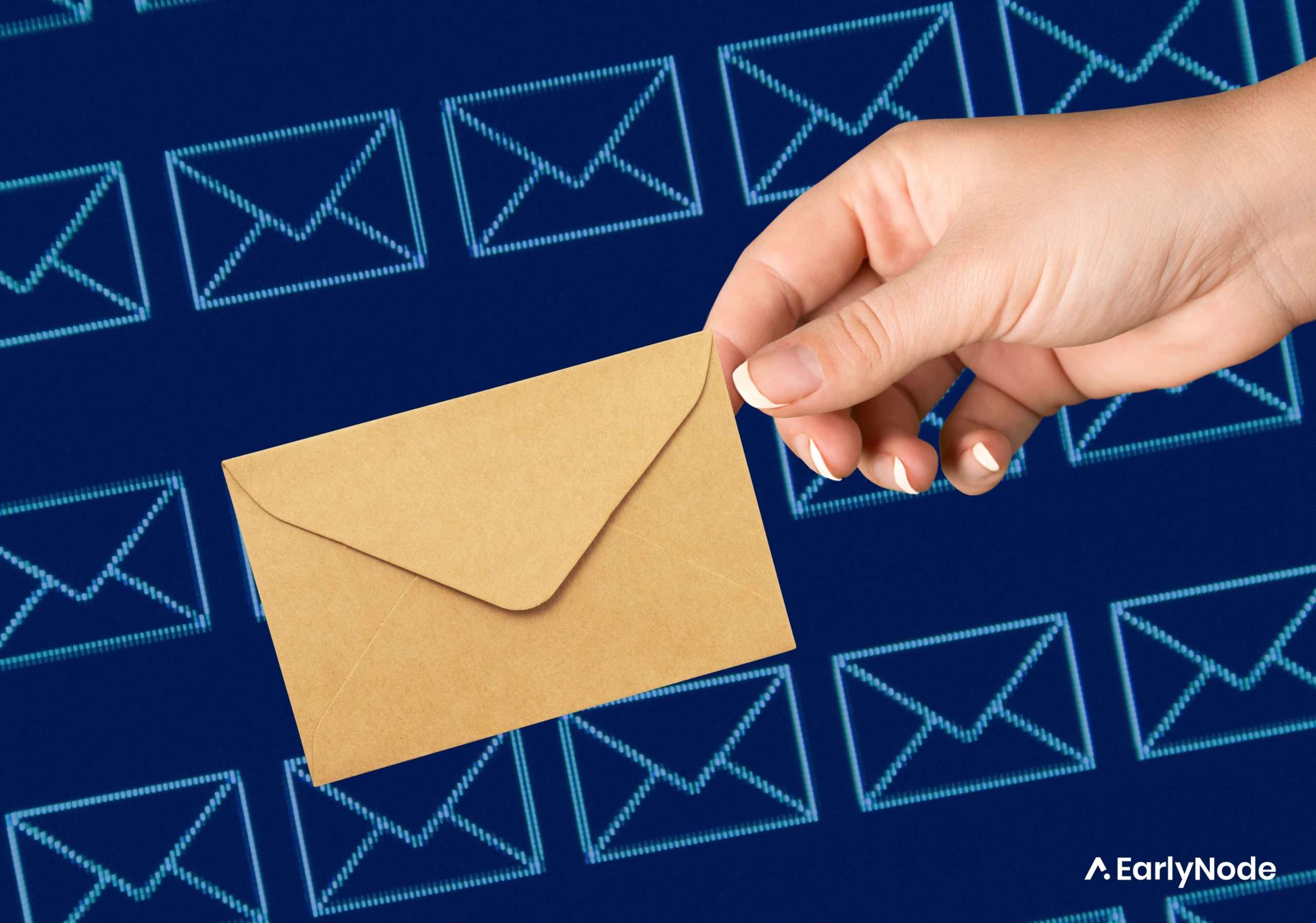The Ultimate Guide to SaaS Release Notes

TL;DR
- Release notes are an efficient way to inform your users about technical updates and improvements.
- The most effective release notes use clear, easy-to-understand language to connect with a range of users.
- Add links and CTAs to emails and in-app pop-ups to direct users to your changelog site for full details.
- Use visuals and video tutorials to explain new features in an engaging way.
A well-written release note can drive users to engage with your product and improve adoption. But many companies underrate this strategy. This guide will take you through everything you need to know about release notes and how to write and distribute them to your users.
What are release notes?
Release notes are documents SaaS companies publish whenever there are new releases or product changes. But they often end up an afterthought for the product team after they’ve spent so much time developing the product. As a result, some companies don’t take advantage of the full benefits of release notes.
There are many important reasons to publish effective release notes.
Why are release notes important for SaaS?
It’s important as a SaaS company to communicate product changes to your customers regularly. This is why:
- It keeps users updated and excited about what you’re working on.
- It’s an opportunity to educate customers on product use cases.
- It’s a chance to entice potential customers – and inactive ones.
- It keeps the sales, marketing and customer success teams in the loop on how changes affect their work.
- It proves to users that your team listens to feedback – a great way to boost user engagement.
Who Is Responsible for Writing Product Release Notes?
In small SaaS companies, it would be the job of a product manager or product marketer to write and publish release notes. When the company grows to between 25-50 people, a Product Marketing Manager handles that task. You can also check the draft with marketing or customer success as well, so they can help tweak the language for your external audience.
What To Include in SaaS Release Notes
There’s no strict format for the content of release notes. The style and content differ from company to company. What matters is that release notes should match your product, audience, and your business goals.
Don’t make them lengthy or bulky. Release notes should contain information users need to know about.
There are some common elements users may expect to see in your release notes:
- Header: This identifies the product name, release date, and release version. It makes it easier to track updates, especially if you publish them many times a month.
- Overview: A brief summary of all the new changes in the latest version for users to understand how it affects them.
- Description: A short description of each update or change. This is the meat of the communication. Some companies go into detail about the changes, adding screenshots to make the explanation easier. Keep the focus on how users benefit from these updates.
- Instructions: List any steps users or admins need to take to try the new release e.g., configurations, prerequisites, hardware, etc.
- Additional resources: Links to video tutorials, user guides, in-depth blog posts, or additional documentation.
You can also use the 4Ws to help you structure your release notes:
- What has been updated?
- Why did you make improvements?
- Where can users access the updates?
- Whom it concerns. Eg admins only, all users, etc.
Things To Avoid With Release Notes
Technical jargon
Yes, release notes describe technical updates about your product, but your users are not technical guys. Unless your main users are highly technical, like developers who understand those terms, it’s best to keep it simple.
Lengthy release notes
Some PMs are guilty of this. Because they have a lot on their plate when preparing for a feature release, they batch a large chunk of text together, making the announcement clunky and difficult to read.
Vague release notes
Users read release notes and look forward to specific details on your updates. You’ve probably seen release notes described like this: “Bug fixes and performance improvements.” or “v2.1.3.21 addresses several security issues”.
The user will be like: “Erm, okay, that’s good news, I guess. Whatever that means”. Why? Because you’ve not really said anything meaningful. Take a cue from Loom. They break down exactly what to expect when you start using their new AI updates.

Luckily there are some good tips for writing release notes your users would love to read.
Best practices for writing release notes
#1 Use simple language
Keep out the jargon. Write release notes like you would explain them to a friend. Focus on your users and the benefits they’ll get from the update.
#2 Keep them short and straightforward
Your users should easily still get the point if they skim through your release notes. If you redesigned the dashboard, just say so. Don’t complicate your message with too many sentences.
#3 Use visual elements
Add gifs, emojis, and images to make release notes interesting to read. Create video tutorials to give users a better illustration of the feature in action. Replace lengthy steps with diagrams or flowcharts.GIFS are another amazing way to present new features; they’re more interactive and give more context to your explanation.
#4 Be consistent with your brand
The tone should reflect your brand personality (e.g., friendly, witty, humorous). Use your brand colors and elements. It helps to have different templates for different kinds of releases, but remember to stay on brand each time.
#5 Link updates to existing features
When you’re sharing the news about new features, make sure to link them with the things your product can already do. That way, you shine a spotlight on your product’s strong points and shows a smooth transition to the improved product.
#6 Organize them logically
Your release notes should be easy to track. Label release notes according to date, feature type (web, app, desktop app), or account type for easy sorting. If your release notes are very long, you can include a short overview of the update and direct users to the longer form with a CTA.
#7 Add relevant links
Especially for new features that users need more info about. Add links to video tutorials, user guides, or walkthroughs for users to understand better. Add a clear CTA at the end for the user to see what they should do next. E.g., “Try it now” or “Watch the tutorial to learn more”.
#8 Invite feedback from your end users
Always include a way for users to send their feedback to help improve your product, whether via a comment section, email, or even a survey link.
Release Notes Template for SaaS
Templates can be a useful way to standardize and speed up your release note-writing process. You’ll need different templates for different types of updates. A release note for a simple bug fix will need to be presented in a different way from bigger feature releases.
Use this template as a guide for your release notes for a feature release.
{Date} {Version}
{Header – Catchy, but clear headline}
E.g.
- {New Feature} is officially out.
- Introducing the all-new {New Feature}.
- Now you can {achieve Outcome} with {New Feature}.
{2-3 sentences introducing your new feature}
This should be exciting and conversational. e.g.
- [New feature] now helps you [save time, work faster, etc.] by [key new functionality and customer value].
{Embedded educational resource. It could be a video, image, or GIF}
Include something that adds visual interest, shows your new feature in action and teaches users how to access the feature e.g. a recorded video of someone on your product team talking about the feature.
{Description of benefits of this feature for users written either as bullets or in a paragraph. At most 100 words}
Here you can talk briefly about what exactly your feature exactly does. The focus, however, should be on the benefits to the customer. List out all the current functions and any functions you’re working on.
{A strong persuasive CTA}
E.g.:
- Click here to try {New Feature} today.
- Check out {New Feature} now.
- Try out {New Feature}.
If you’d like to get your hands on templates for different types of SaaS release notes, we’ve created an in-depth breakdown of exactly that. You can read the article here.
How To Announce Release Notes
Now that you know how to write a good release note, you need to distribute it through different channels. Here are 5 ways:
1. Standalone changelog site
A changelog site gives you a dedicated platform for all your release notes. You can keep a chronological record of all updates, which works well for end-users and your internal team. Luckily, you don’t need to build this from scratch. ReleaseLog is a changelog tool for busy SaaS founders and PMs that allows you to publish your release notes with beautiful templates in minutes.
2. In-app widgets
You can also use an embeddable widget to keep users informed and engaged directly in your app. Tooltips, modals, and slideouts are a few ways to publish your release notes to users in context. For maximum effect, give a short description in the popup, then link to the changelog page for the full details.
3. Email
An advantage of email is that users can get release notes even if they only use your app occasionally or you don’t have many chances to reach them. Email is also a good way to re-engage inactive users to bring them back into your app. You can also mix things up and send different emails to different user segments to make them more relevant to them.
4. Blog posts
Surprisingly, this isn’t so common, but it’s effective in keeping users engaged, especially if your blog attracts a lot of traffic. You can use the blog to cite new use cases for feature updates.
A best practice is showcasing how your new features make certain use cases possible or easier. This kills two birds with one stone: You show current users new ways to use your product, and you give prospects a chance to picture themselves using your product for a use case that is interesting to them.
Here’s an excellent example from Slack. In this blog post, they showed how to use their new clips feature to share audio and video content into any channel or DM, and teammates can watch and respond regardless of timezone, enhancing async communication.
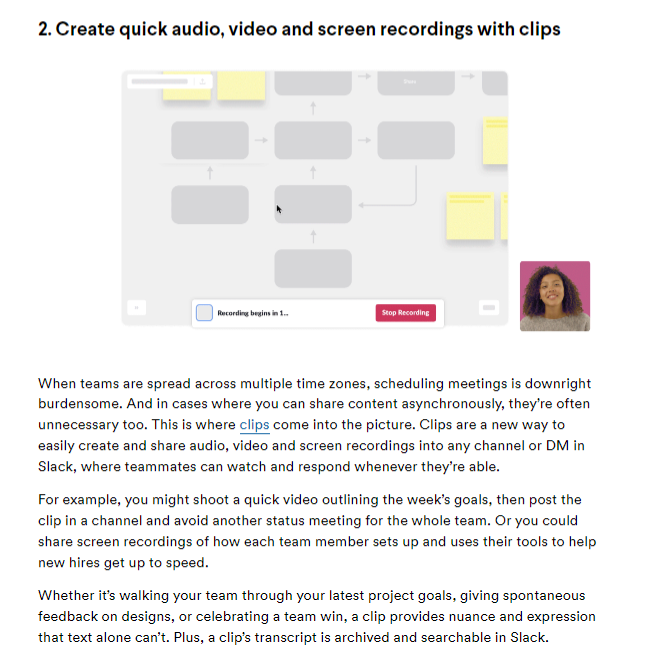
5. Social media
Some SaaS companies use Twitter or LinkedIn to share improvements and fixes. The channels make it easy to build engagement and even respond to questions and feedback from users. You get the nice bonus of attracting new customers too.
Great SaaS release notes and changelog examples
#1 Ahrefs
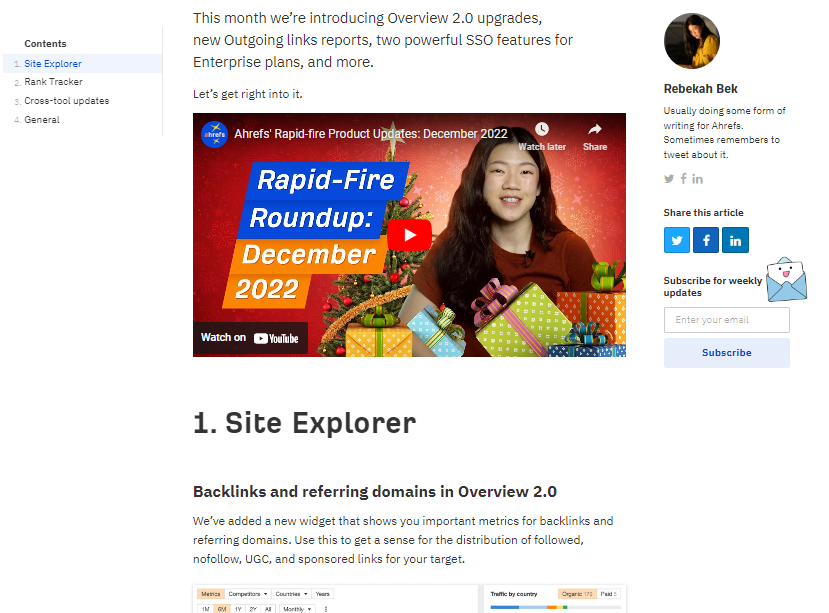
Ahrefs uses their blog to write in-depth release notes. You can see how they embed tutorial videos to explain their updates to users in a more engaging way. Headings and language are simple and straightforward. They add a banner at the top of the web page to notify users about new updates.
#2 ClickUp
ClickUp’s style is unique and in line with its “fun and friendly” brand voice. We love how they use conversational language to explain changes. There’s no technical jargon, making it easy for users to understand. The emojis, screenshots, and images spice up the text to make it visually appealing. It’s certainly something you would love to read.
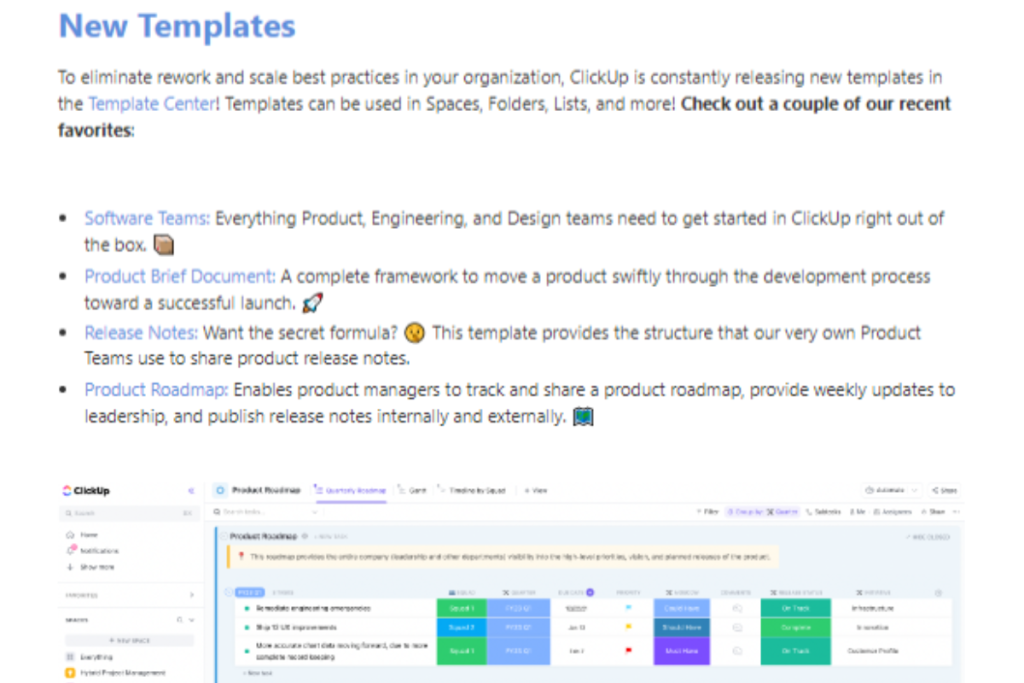
#3 Slack
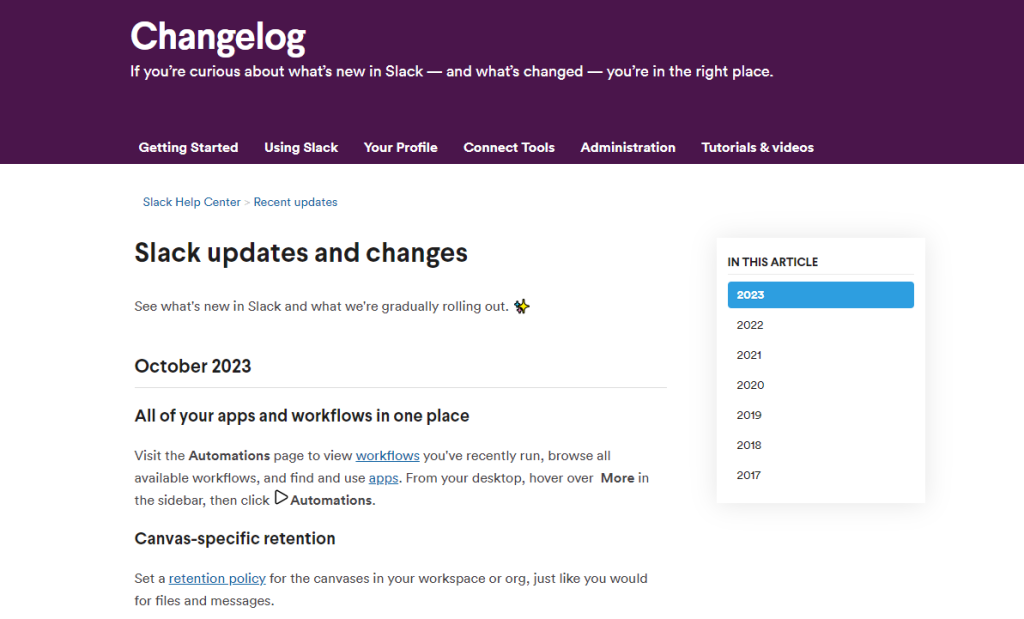
Slack’s changelog is well-organized. You can easily navigate through each update and sort by month or year. You can also see the conversational style in how Slack shares updates. And the emojis are also in line with the company’s casual vibe.
#4 TL;DV
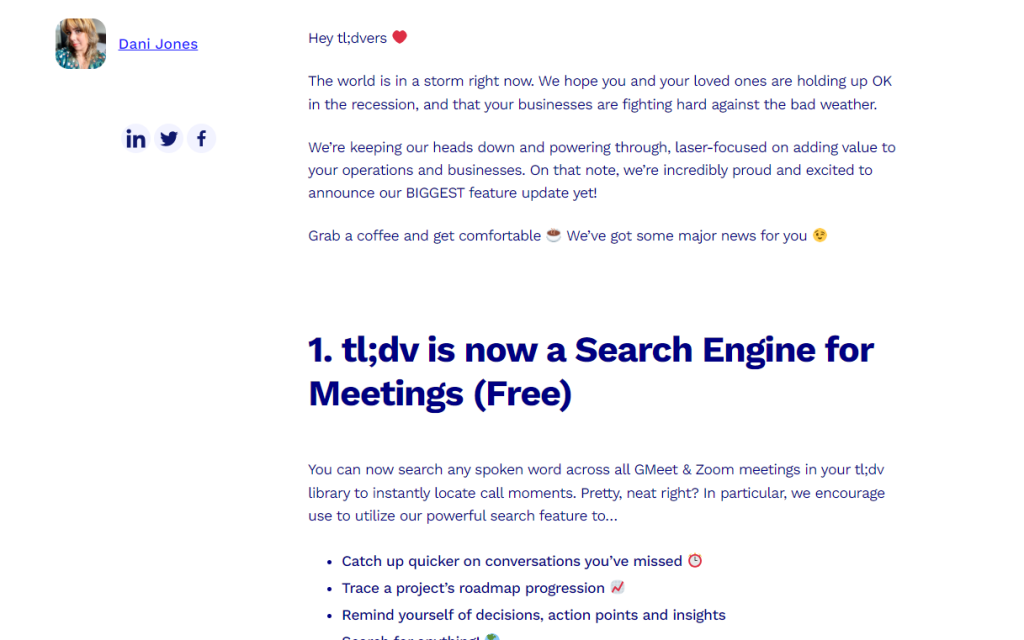
Tl;dv is another perfect example of publishing updates through your blog. You can take a cue from the bulleted list, which gives a quick overview of the updates in the new version. Once again, tl;dv uses lots of emojis to communicate and make the post more engaging.
#5 Notion

Notion uses interactive and engaging GIFs. The gifs give the reader more context and does more of the talking about the update. That way, Notion doesn’t have to communicate with a lot of text, as you can see above. The headings include hyperlinks to easily redirect users to try out the update.
Best Tool for Publishing SaaS Release Notes
You need a simple changelog tool that lets you publish release notes in minutes without hitches. We recommend you look for one that helps you maintain a consistent brand identity with many customization options. The EarlyNode team built Releaselog just for that. It’s ideal for busy SaaS founders and PMs, plus it’s easy on the pocket.
